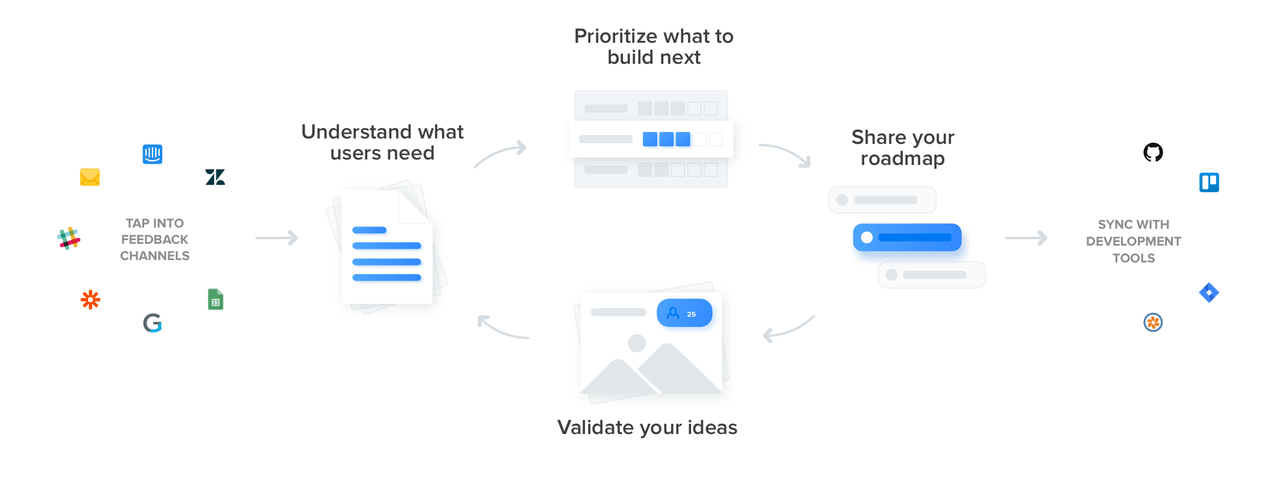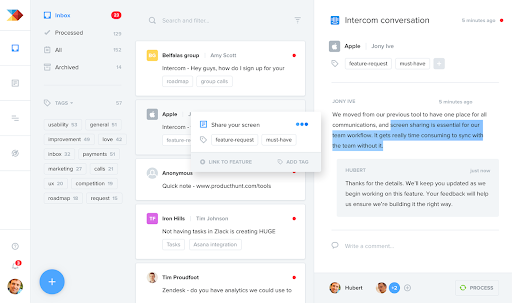The difference between product development and product management tools — and why you need both

Product Development vs. Product Management Tools
Product development and product management are fundamentally different functions — but they’re both essential when it comes to developing products that users love.
For many teams, though, the line between product management and product development can become blurry. Product managers shoehorn their work into a tool not built for the job. Engineers struggle with a lengthy backlog that is not prioritized by strategic criteria.
Don’t get us wrong. Product development tools like Jira and Microsoft’s Azure DevOps platform are important for keeping projects on track. The problem is that these product development tools don’t support the core responsibilities of the product manager — namely, prioritizing the right features to work on next. That’s why so many product teams are adopting dedicated product management tools alongside their engineering team’s development tools.
The intersection of product development and product management
The product manager’s function is a necessary intermediary between customer-facing teams and stakeholders across the business.
Product teams are tasked with all of the following:
- Collecting and organizing feedback from inside and outside the organization
- Understanding what users need
- Ensuring that product and feature ideas align with company objectives
- Assessing whether proposed ideas are technically feasible
- Prioritizing what to build next
This entire process can be managed within a dedicated product management system, and the primary output is a product roadmap — the near-term and long-term vision of where a company is headed via its products, features, and solutions. The roadmap flows smoothly into the development process, forming the basis for the development team’s work.

These projects and feature ideas are then broken down into technical tasks. Product development tools help the dev team manage these tasks as they go into production.
At least, that’s how the process works in an ideal world. Problems arise when product and development teams try to use the same tool to manage their individual processes. And for most organizations, this tool is dictated by what the development team is already using.
The drawbacks of keeping everything within a product development tool
Product development tools are great for their intended purpose of managing development-related tasks, but they aren’t built to support the product management process.
Product development tools overlook customer pain points in favor of solutions
Because product development tools are built for just that — development — it’s easy to skip the important step of identifying and validating customer pain points and instead jump straight into assuming a particular solution. And when a solution is based on assumptions instead of on data and true customer needs, teams end up wasting time on products that miss the mark.
Product development tools are built for execution, not planning
Product development tools like Jira aren’t designed to help understand users or prioritize what to build next — they’re optimized for delivery. Another shortcoming for product managers is a lack of a clear way to visualize and share a high-level roadmap of releases.
While Jira works well for keeping development on schedule, it’s not flexible enough to determine what gets on the roadmap in the first place — a crucial part of the product manager’s role. Even advances like Jira’s Advanced Roadmaps serve mainly as visualizations of the engineering team’s plans, and it’s a tall order to get non-engineers to log in to Jira to view them.
Keeping everything in a single tool overwhelms everyone
Last, but certainly not least, dumping everything in a product development tool overwhelms everyone involved.
Developers bump heads when all their tasks are spread across different stages of ideation, validation, and design without clear indicators of what’s ready to be worked on. Product managers struggle to prioritize and plan given the limitations. And stakeholders have no way to track the status of work taking place, slowing down development and increasing the risk of building the wrong solution.
A dedicated product management tool complements existing development tools
At the end of the day, a product development tool like Jira is great for developers, but not for product managers.
A dedicated product management system is a perfect partner for existing development processes, acting as a filtering layer that comes before tasks are funneled into development tools.
The good news is that you can have the best of both worlds — without giving up any tools. A dedicated product management system is a perfect partner for existing product processes, acting as a filtering layer that comes before tasks are funneled into development tools:
- Ideas flow into your product management tool.
- These ideas can be validated, categorized, and prioritized effectively into a product roadmap.
- The product roadmap is pushed into production and automatically syncs downstream into your development tool.
Instead of product development versus product management, both systems and teams can work together to deliver products that people use and love.
Product managers benefit from increased visibility and control of their roadmap
It can be difficult to gain visibility into the status of a feature or idea when everything is tracked in the same product development tool, and adding additional statuses for research, discovery, validation, and backlog grooming can quickly overwhelm everyone involved.
Instead, a dedicated product management system gives product managers the control they need to deliver great products. Product teams can score and prioritize tasks and stories more effectively, defining product objectives and drivers around common product prioritization frameworks. The value of these individual drivers can then be rolled up into a true prioritization score, weighted according to exact needs.
Product managers can have a home of their own to think about high-level customer needs and objectives. And when they’re ready to pass the torch to the development team, features can be automatically synced between the two tools with minimum fuss.
Developers can focus on the highest-value tasks without distraction
Developers benefit, too. From their perspective, product management systems act as a big filter that keeps their tool from getting cluttered. From now on, the only things that get pushed into their workflow are prioritized features aligned with company objectives.
Product management systems act as a big filter that keeps product development tools from getting cluttered.
Developers also gain access to the “why” behind every idea and feature. Each task in their workflow is linked back to the product management system where customer feedback, notes, and more are accessible with just a single click. Understanding the problem behind what they’re building helps unlock the creativity of engineers and motivates them to design the best possible solution.

Get the right products to market, faster
With a dedicated product management system, product managers finally have a home of their own. Product managers get to use a dedicated project management solution for their process, and developers can continue using the tools they love for day-to-day project management.
It’s time you nixed the messy and overwhelming backlog. Sign up for a free Productboard trial today and see why top product teams use Productboard.



![The CPO’s Blueprint for Annual Planning: An Opportunity to Drive Change [Part 3]](https://www.productboard.com/wp-content/uploads/2024/11/strategy-blueprint-560x293.png)
